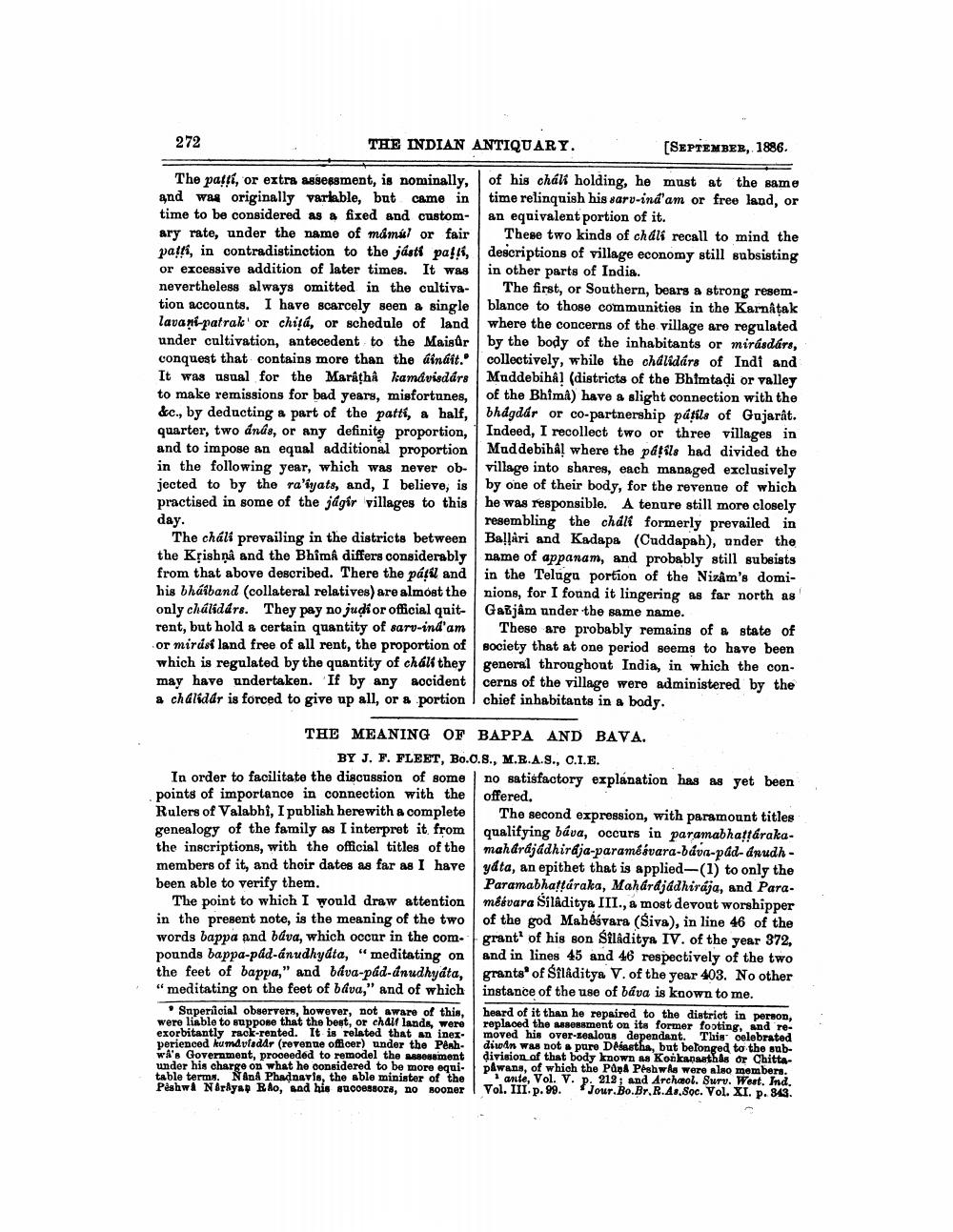________________
272
THE INDIAN ANTIQUARY.
(SEPTEMBER, 1886.
The patti, or extra assessment, is nominally, of his cháli holding, he must at the same and was originally variable, but came in time relinquish his sarv-ind'am or free land, or time to be considered as a fixed and custom- an equivalent portion of it. ary rate, under the name of mamul or fair These two kinds of chali recall to mind the patti, in contradistinction to the jástí palí, descriptions of village economy still subsisting or excessive addition of later times. It was in other parts of India. nevertheless always omitted in the cultiva. The first, or Southern, bears a strong resem tion accounts. I have scarcely seen a single blance to those communities in the Karnatak lavani-patrak' or chițá, or schedule of land where the concerns of the village are regulated under cultivation, antecedent to the Maisůr by the body of the inhabitants or mirásdárs, conquest that contains more than the dinait. collectively, while the chalidárs of Indt and It was usual for the Marathi kamdvisdárs Muddebiha! (districts of the Bhimtadi or valley to make remissions for bad years, misfortunes, of the Bhima) have a slight connection with the &c., by deducting a part of the patti, a half, bhdgdár or co-partnership pátils of Gujarat. quarter, two ánás, or any definite proportion, Indeed, I recollect two or three villages in and to impose an equal additional proportion MuddebihA! where the pafile had divided the in the following year, which was never ob- village into shares, each managed exclusively jected to by the ra'iyats, and, I believe, is by one of their body, for the revenge of which practised in some of the jágir villages to this he was responsible. A tenure still more closely day.
resembling the chali formerly prevailed in The chali prevailing in the districts between Ballari and Kadapa (Cuddapah), under the the Krishna and the Bhimâ differs considerably name of appanam, and probably still subsists from that above described. There the páčil and in the Teluga portion of the Nizâm's domihis bháiband (collateral relatives) are almost the nions, for I found it lingering as far north as only chálidárs. They pay no judíor official qait- Gazjâm under the same name. rent, but hold a certain quantity of sarv-ind'am These are probably remains of a state of or mirasi land free of all rent, the proportion of society that at one period seems to have been which is regulated by the quantity of cháli they general throughout India, in which the conmay have undertaken. If by any accident cerns of the village were administered by the & chalidar is forced to give up all, or & portion I chief inhabitants in & body.
THE MEANING OF BAPPA AND BAVA.
BY J. F. FLEET, BO.O.S., M.B.A.S., C.I.E. In order to facilitate the discussion of some no satisfactory explanation has as yet been points of importance in connection with the offered. Rulers of Valabhi, I publish herewith a complete The second expression, with paramount titles genealogy of the family as I interpret it from qualifying báva, occurs in paramabhattarakathe inscriptions, with the official titles of the maharajadhiraja-paramósvara-báva-pád-dnudh - members of it, and thoir dates as far as I have ydta, an epithet that is applied-(1) to only the been able to verify them.
Paramabhaftáraka, Maharajadhiraja, and ParaThe point to which I would draw attention mêsvara SilAditya III., a most devout worshipper in the present note, is the meaning of the two of the god Mahéśvara (Śiva), in line 46 of the words bappa and bava, which occur in the com- grant of his son Siladitya IV. of the year 372, pounds bappa-pád-ánudhyata, “meditating on and in lines 45 and 46 respectively of the two the feet of bappa," and báva-pád-dnudhyáta, grants' of Siladitya V. of the year 403. No other "meditating on the feet of bava," and of which instance of the use of båva is known to me.
Superiicial observers, however, not aware of this, heard of it than he repaired to the district in person, were liable to suppose that the best, or chal lands, were replaced the assessment on its former footing, and reexorbitantly rack-rented. It is related that an ines. moved his over-sealous dependent. This celebrated perienced kumdvladar (revenue officer) under the Pesh- diwin was not pure Désastha, but belonged to the subwa's Government, proceeded to remodel the assessment division of that body known as Konkanasthås or Chitta. under his charge on what he considered to be more equipawans, of which the PdpPeshwhs were also members. table terms. Nana Phadnavis, the able minister of the ante, Vol. V. p. 212; and Archeol. Sury. West. Ind. Peshwi N Brayap BAO, sad his successors, no sooner Yol. III. p. 99. Jour.Bo.Br. R.As.Soc. Vol. XI. p. 843




